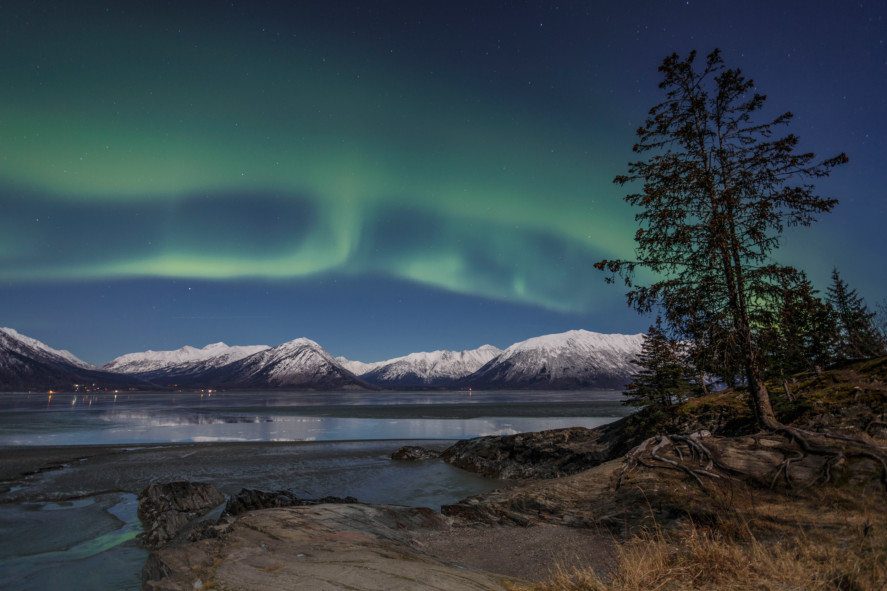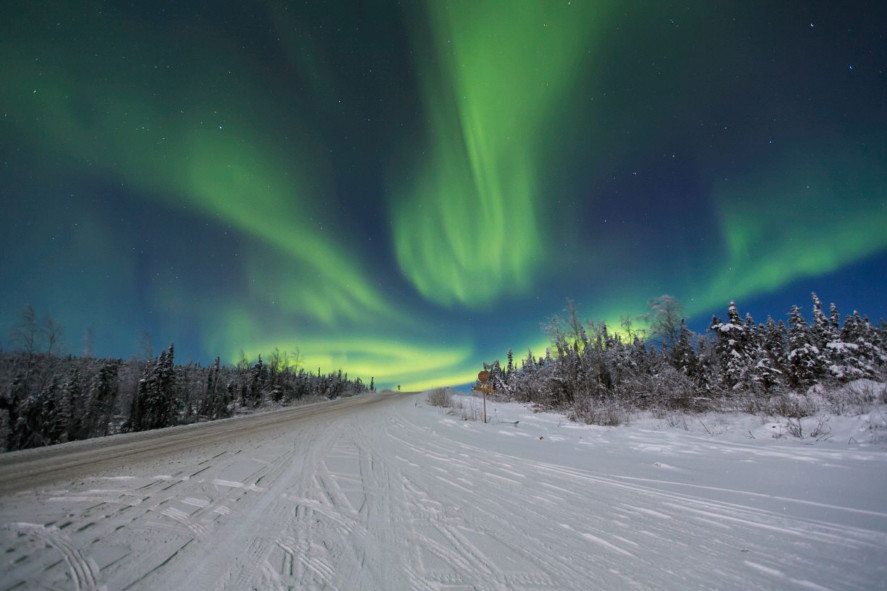Alaska’s captivating Aurora Borealis, also known as the Northern Lights, may seem mystical, but it’s a phenomenon grounded in science and magnetism rather than magic. Alaska is one of the best places in the world to view the Northern Lights due to its location directly under the Auroral Zone, so planning a trip to see the Northern Lights in Alaska is a must for adventure seekers. The best time for Northern Lights viewing in Alaska is during the winter months, from September to April when the nights are long and dark.
In this guide, we’ll unveil the secrets and some key tips for experiencing this enchanting spectacle in the Alaskan skies. We’ll cover everything from the science behind the lights to the best locations for sightings.

Northern Lights (Aurora Borealis) in the sky on the Chugach Mountains that jut above Indian area and Turnagain Arm taken from Hope Seward Highway
The Science of the Northern Lights
To appreciate the Northern Lights truly, you must grasp the science behind them. The Northern Lights phenomenon is created when the Earth’s magnetosphere is disrupted by the sun’s powerful winds and massive eruptions, creating geomagnetic storms. This results in atoms, electrons and protons colliding to produce radiant bursts of light.
These vibrant and changing lights, which linger on for minutes or even hours, manifest as swirling bands and blankets, spanning the color spectrum from the typical greens and yellows to the rarest reds. Whether they appear nearby or distant, these lights never fail to captivate observers.
The key to viewing the Northern Lights at their finest lies in understanding the solar cycle and equinoxes. Peak aurora activity often coincides with the sun’s periods of high-energy flares. The optimal time for viewing is between 9 p.m. and 3 a.m., when the skies are darkest.
Where is the Best Place to See the Northern Lights in Alaska?
Alaska is a prime destination for viewing the Northern Lights due to its proximity to the “auroral zone,” a narrow band between 3-6 degrees in latitude, situated 10-20 degrees from the geomagnetic North Pole. This geographical advantage makes Alaska a hotspot for aurora displays, especially within the 65-70 degrees north latitudes. The best places to see the Northern Lights in Alaska are in the northern regions of the state, such as Fairbanks, Denali, and the North Slope. If you are in the Aurora viewing zone for three nights or more, you have a 90% chance of seeing the northern lights!
The Auroral Zone
The auroral zone, where Earth’s magnetic field is strongest, provides the ultimate vantage point for Northern Lights enthusiasts. Stretching across countries such as Finland, Sweden, Norway, Iceland, Greenland, Canada, and notably Alaska, it offers unmatched opportunities to embark on an aurora-viewing quest. Alaska’s proximity to Northern Canada ensures that it consistently ranks among the best places to see the Northern Lights. The clearer the skies, the greater are your chances of seeing the northern lights, but it is even possible to see the northern lights with scattered clouds and even light snow flurries. Alaska’s aurora viewing zone offers more clear nights than other locations like Iceland, which is on the coast and has greater chances of clouds and precipitation.
Fairbanks, Alaska
Fairbanks, Alaska, is a Northern Lights paradise situated beneath the Aurora Oval. Here, the University of Alaska Fairbanks’ Geophysical Institute forecasts that the prime aurora viewing window extends from 9 p.m. to 3 a.m., with midnight being the optimal time. The institute’s data highlights February to early April as the peak months for aurora activity due to the equinox and clearer spring skies. Remember to consider factors like light pollution, cloud cover, and weather conditions for your Fairbanks northern lights tour.

The UAF Aurora Tracker
North Slope Towns
Beyond Fairbanks, other Alaskan gems like Coldfoot, Prudhoe Bay, and Utqiagvik/Barrow, offer excellent Northern Lights viewing opportunities. North Slope towns, in particular, stand out for their remarkable displays, making them sought-after destinations for avid aurora chasers.

Northern Lights by James W. Dalton Highway
Tips for Viewing the Northern Lights in Alaska
Before embarking on your Northern Lights viewing adventure, it’s essential to be well-prepared. In this section, we’ll share valuable tips to enhance your Northern Lights viewing experience.
- Dress Warmly: Alaskan nights can be frigid, so ensure you’re bundled up in layers to stay comfortable during extended viewing sessions.
- Pack a Camera and Tripod: Capture the magic of the Northern Lights with stunning photographs. A tripod will help you capture steady, long-exposure shots.
- Patience Is Key: The Northern Lights can be unpredictable, so be patient and persistent. Sometimes, the best displays are worth the wait.
Checking the Aurora Forecast
Stay updated with the aurora forecast to increase your chances of viewing the Northern Lights. You don’t need an advanced degree in solar sciences—just a reliable internet connection. Several websites, social media pages, and smartphone apps, such as the Aurora forecast and tracker on the UAF Geophysical Institute website, offer real-time information, including satellite data, charts, and user comments, which can help increase the odds of finding the lights. Additionally, consider professional guides that specialize in Alaska northern lights tours and Alaska hotels that may alert you when the aurora graces the night sky.
Getting Out of Town
For the best Northern Lights viewing experience, escape urban areas. City lights can diminish the brilliance of the aurora borealis. Mountaintops, wilderness roads and lake shores are some of the best places where you can view the Northern Lights clearly. And even if the northern lights forecast calls for heavy aurora action, it won’t matter if the sky is filled with clouds that can obstruct this natural light show. Contrary to common belief, the Northern Lights can appear even on warm fall nights, so be ready for an awe-inspiring show.
Booking a Northern Lights Tour
Booking a Northern Lights tour can greatly increase your chances of seeing the lights. Experienced tour guides will know the best places to see the Northern Lights in Alaska and can provide you with transportation and equipment. You might even be wondering “how much is a trip to Alaska to see the northern lights?”, and the answer isn’t that straightforward. Alaska Tours offers a variety of tours, including the Fairbanks Northern Lights Viewing Tour and the Anchorage Aurora Quest Tour, among others, all of which can vary in price. These tours provide a safe and immersive guided experience, taking you to remote locations away from city lights, such as the Borealis Basecamp and Northern Lights Tour or the Arctic Circle Northern Lights Tour.
The Northern Lights: A Truly Unforgettable Experience
The Northern Lights are indeed a magical sight to behold. While predicting the Northern Lights is not an exact science and a bit of luck is involved, understanding the science and other factors can significantly enhance your chances of viewing this breathtaking spectacle.
As you plan your trip to see the Northern Lights viewing adventure, consider exploring Alaska Tours’ Northern Lights tour packages, which offer a range of experiences and destinations. Ready to embark on your Aurora viewing journey? Contact us to learn more about our Northern Lights viewing tours, and book your unforgettable Alaskan adventure today
